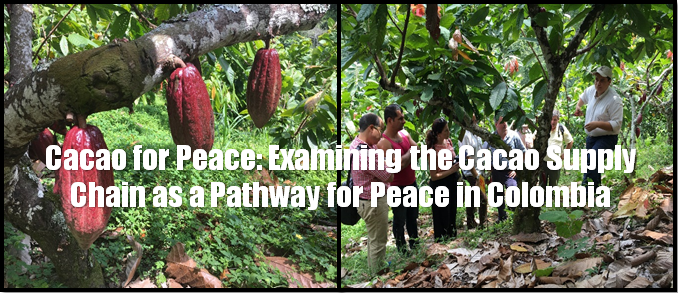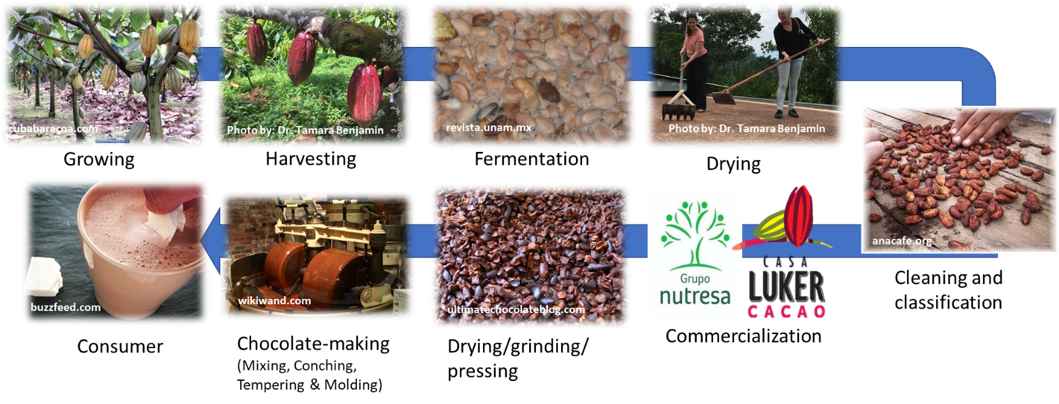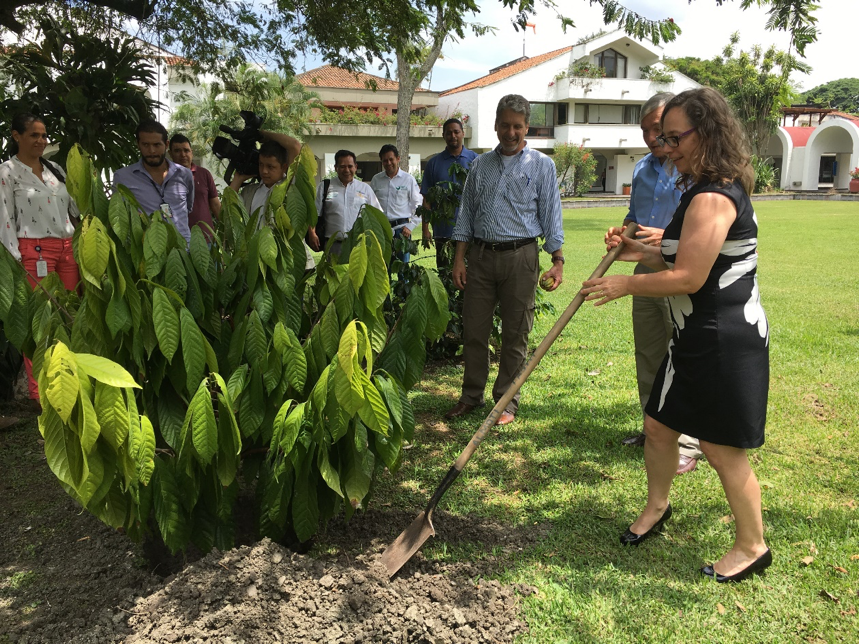


After more than 50 years of armed conflict, the new post-conflict era in Colombia brings both challenges and opportunities. While the Colombian government reached a peace agreement with the Revolutionary Armed Forces of Colombia (FARC) at the end of 2016, others were working on ways to foster a lasting peace through economic development initiatives. Here, we will discuss a U.S. Department of Agriculture (USDA) led initiative called Cacao for Peace.

Cacao is the key ingredient in chocolate and has been cultivated in Colombia for centuries. Several regions in Colombia, with agricultural potential to grow cacao beans, were sites fully dominated by violence before the peace agreement. As a consequence, local farmers were displaced from violence or coerced to remain and cultivate coca. Examples of these sites are: Arauca, Norte de Santander, Montes de María (Sucre and Bolivar), Antioquia (North), Chocó (Mid and lower Atrato basin), Valle del Cauca, Cauca, Tumaco (Nariño), and Caquetá.
Cacao for Peace emerged to help these farmers transition from an uncertain environment fueled by violence to the production of cacao, while boosting their economic stability, and more broadly, improve the cacao supply chain in Colombia. For a much more detailed introduction to the project, please read an article that CPI published in a previous issue.
Purdue University and the International Center for Tropical Agriculture (CIAT) worked together in the design of a baseline study to better understand the current and potential status of the cacao supply chain in Colombia. An extensive literature review was conducted and a wide variety of data were analyzed at the industry and global-level. These efforts were synergized with more than 100 stakeholder interviews, and inclusive and participatory workshops to involve as many key stakeholders participating in the Colombian cacao supply chain. Four aspects of the Colombian cacao supply chain were studied: 1) delineating the pathway of cacao beans from farm to consumer, 2) economics of cacao production, 3) roles of actors in the cacao supply chain, and 4) global and local cacao market context and considerations.
The Purdue interdisciplinary team was led by Dr. Tamara Benjamin (Horticulture and Landscape Architecture), and consisted of the following working group members: Dr. Philip Abbott (Agricultural Economics), Dr. Michael Wilcox (Purdue Extension and Purdue Center for Regional Development), Dr. Gary Burniske (Center for Global Food Security), Colleen Kelly (graduate student in Youth Development and Agricultural Education), Dr. Marcia Croft (then a graduate student in Horticulture and Landscape Architecture), Marieke Fenton (graduate student in Agricultural Economics), and Dr. Jeffrey Stuart (Entomology).
Main conclusions
The team collected information from important cacao production sites in Santander, Tumaco (Nariño), and the Sierra Nevada, where smallholder farmers separate cacao beans from the pods which in turn are fermented, and dried. Over 80% of the Colombian cacao is purchased locally by Casa Luker and Grupo Nutresa. The following flowchart shows the steps it takes to transform cacao beans to chocolate.
 |
Colombians, different from most people from cacao-producing countries, have a strong tradition of consuming cacao as part of their diet. Most of the cacao produced in Colombia is consumed internally, and a small portion is exported. In 2016, Colombia had over 38,000 cacao farmers, and produced more than 56,000 metric tons from which more than 80% was consumed internally. Moreover, the percentage of the international cacao price that Colombian cacao beans command at the farmgate is higher than in Ecuador, Peru, Cote d'Ivore, and Ghana. As a perennial tree crop, this positions cacao as a potential opportunity for Colombian farmers to positively impact their household income as well as diversifying their portfolio of crops. In addition, Colombian cacao is sought after on the world market by chocolate companies across the globe. Hence, Colombia has a market positioning opportunity inside and outside the country. "With great opportunities, come great commitments and responsibilities" says Dr. Benjamin.
 |
| Dr. Tamara Benjamin helping to plant a cacao tree at CIAT with the Director General, Ruben Echeverría, and the US Ambassador, Kevin Whitaker, during the Cacao for Peace commission meeting in April 2017. |
Although the cacao production areas in Colombia have increased significantly in the last two decades, the crop yield has in fact decreased. In order to reverse this trend, the country needs to plan strategically for the development of several areas, such as technical assistance to cacao farmers, infrastructure to help smallholder farmers access buying and post-harvest stations, and research about Colombian cacao varieties and pest management. The following stages of Cacao for Peace aim to address these issues.
A Cacao for Peace commission met on April 25th at the Tropical Agriculture Research Center (CIAT) in Cali, Colombia, to discuss the results from the first stage of the project and future directions. Dr. Benjamin assisted in representing Purdue University and presented the main findings of the first stage of the project. The Purdue team is optimistic about these results and suggests that Colombia focus their efforts on supplying primarily the internal market, and positioning itself in the international market with the production of higher quality cacao. In the meantime, four Colfuturo-USDA scholarship recipients will be selected to study at Purdue University to pursue master degrees on several aspects of Colombian cacao production (i.e., economics, horticulture, food science, social science, etc...). We congratulate our Purdue students, staff, faculty and administrators for their hard-work and for touching many lives with this project. Boiler up!
Last modified: December 4, 2023